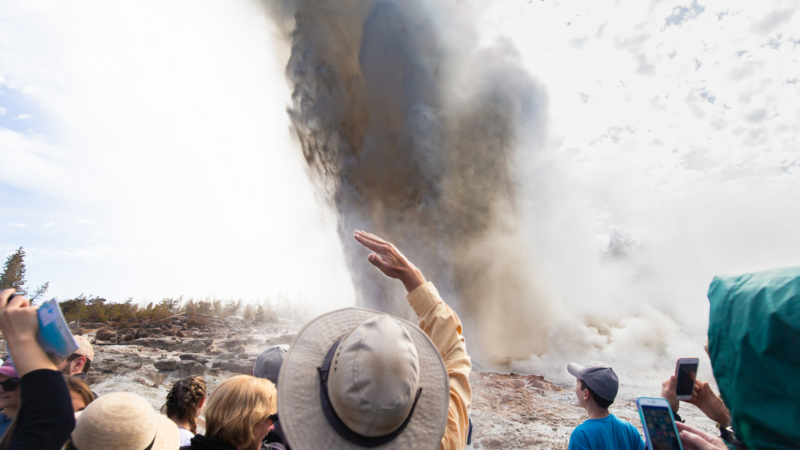Alabama Appalachian Trail
“He could’ve used it twenty years ago when he and a buddy hiked the Appalachian Trail, or A-T as it’s known. It was an arduous two-thousand mile trek.
“There were days where it was more work than it was fun. You had to get up every morning, put on that pack and get the job done.”
It was remembering that five-and-a-half-month hike and being curious about nature from his days in the Boy Scouts that got Lein involved in state conservation. Ultimately, he would help others piece together the Alabama land that now connects to the A-T.
Outdoor tourism officials and state boosters like Stewart Dansby say that’s a no-brainer.
“Most people in the country don’t know much about geography. People need to know the Appalachian Mountains end in north-central Alabama.”
That effort began recently at Mt. Cheaha.
Workers gingerly placed a massive granite and limestone boulder and plaque that commemorate the completion of the Pinhoti Trail. At a dedication ceremony, attorney Mike Leonard – whose idea spans twenty-five years – said the pathway is a window to and for the world.
“I believe in the state of Alabama; I believe in the beauty of this state. And I believe that it is something that the rest of the country needs to know about, they need to appreciate.”
It was the conservationist Benton MacKaye who, in 1921, envisioned the Appalachian Trail as a refuge from the urban environs of the east coast. And now, the Alabama Pinhoti meanders 115-miles to the Georgia border – and ultimately, to Springer Mountain, the original southern endpoint of the A-T in Georgia.
Tom Cosby with the Birmingham Regional Chamber of Commerce says the original northern endpoint was in New Hampshire, but was officially extended. The same, he says, could happen in Alabama.
“Our hope is, with time – I don’t know, 5 years, 10 years, 20 years – at some point perhaps the Appalachian Trail Conference would say, ‘well you know, so many people hike the entire length of the Appalachians. And they don’t end at Springer Mountain, they actually end in Alabama, why don’t we sanction it and say that the Appalachian Trail ends in Alabama?”
Cosby says state officials haven’t officially asked for the trail to be extended into Alabama, but they hope it will become sort of a de facto end and eventually be recognized.
For their part, Georgia officials at a state park near Springer Mountain say they have no position on the Alabama plan – which could siphon people and tourist dollars away.
The Appalachian Trail Conservancy has also not taken an official stand. But Executive Director David Startzell says such a move would require an act of Congress.
“It would have to be an amendment to the National Trails System Act, which provides, a, you know, fairly general description of the route of the trail. But, you know, it’s detailed enough, that clearly an extension into Alabama wouldn’t fit the current definition.”
The National Trails System Act of 1968 places both endpoints at Mount Katahdin, Maine, and Springer Mountain, Georgia. So the wording would have to be changed. Regardless, the Alabama Pinhoti is there for the hiking. No matter what it’s called, it is an uninterrupted path all the way to Maine.
Mass trial shines a light on rape culture in France
A harrowing and unprecedented trial in France is exposing how pornography, chatrooms and men’s disdain for or hazy understanding of consent is fueling rape culture.
Teammates LeBron and Bronny James make history as the NBA’s first father-son duo
The Jameses, who both play for the L.A. Lakers, shared the court for several minutes on the NBA's opening night. They join a very small club of father-son teammates in American professional sports.
When Steamboat goes WHOOSH, scientists look for answers
What triggers geysers to go off is still not well understood. A new paper shows that one small earthquake likely triggered an eruption of the world's tallest active geyser, Steamboat.
Trump’s ex-chief of staff warns his former boss would rule like a ‘fascist’
John Kelly is one of several Trump-era White House officials to publicly criticize their former boss, arguing that Trump is not fit to hold office again.
An attack on a Turkish defense company has killed 4 people
Assailants set off explosives and opened fire in an attack on the premises of the Turkish state-run aerospace and defense company TUSAS, causing a number of casualties.
Boeing posts a $6 billion loss as striking workers vote on a new contract
Boeing reported a staggering loss of $6 billion dollars in the third quarter. The disappointing earnings report comes the same day as striking machinists are voting on a new contract offer.






